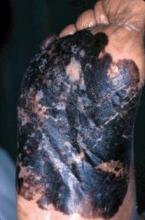Melanoma accounts for 75% of all skin cancer deaths. Ultraviolet exposure is still targeted as the major etiologic factor, but for black patients, skin erythema has been estimated to occur at a UV radiation dose 6-to-33 times greater than that experienced by white patients. Many have concluded that this is why black patients experience lower rates of melanoma than white patients.
Black patients, however, present at a later stage and have a higher melanoma-specific mortality, both of which have been linked to time of diagnosis and the ability to seek care at the onset of localized disease. Thus, there still exists a barrier to the detection and treatment of melanoma in black patients.
In the July issue of Archives of Dermatology (2012;148:797-801), an article highlighted the anatomic distribution of malignant melanoma in the non-Hispanic black patient in an effort to explore how distribution of melanoma relates to UV exposure.
Data from 46 population-based cancer registries were analyzed. The most frequent site of melanoma in non-Hispanic black patients – both male and female, between the years 1998 and 2007 – was found to be the lower limbs and hip (58.9%). Of those, 27% were of the acral lentiginous type, which is not associated with exposure to UV rays.
The second most common location was the trunk (16.5%), which affected patients at a younger age; 46% of females and 31% of males were less than 44 years of age. The median age was 56 years for males and 48 years for females at presentation.
This study reiterates the burden of melanoma in the black community. It also highlights gaps in the detection of melanoma, which may be because of site of diagnosis – such as those of the acral lentiginous types – and unclear risk factors, the general underestimation of risk, and access to care.
- Lily Talakoub, M.D.
Do you have questions about treating patients with darker skin? If so, send them to sknews@elsevier.com.


